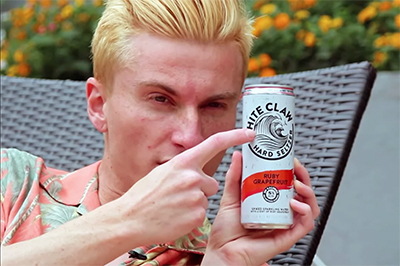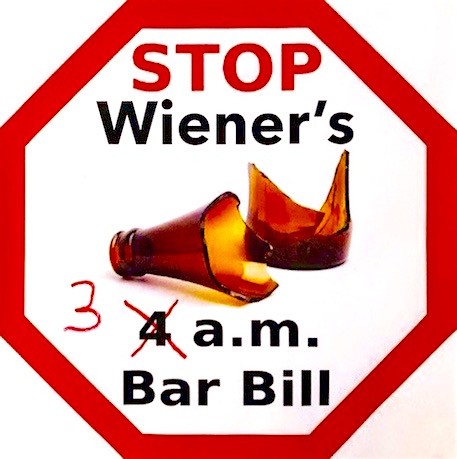Blog
New Hard Seltzer and the Big Old Lie
- Details
- Created: Wednesday, November 27 2019 19:54
 No beverage product has received more publicity over the past year than hard seltzers. These colorless carbonated alcoholic drinks often come with the same faint fruit flavors of La Criox. Hard seltzer brands such as White Claw, Bon & Viv, and Truly advertise their low calories, lack of gluten, and inclusion of fruit. It's nice to think that consumers, jaded on the repeated, deceptive, manipulative, and sometimes overtly corrupt efforts to connect alcohol to health, are immune to the "healthy drinking" scam. But hard seltzers are one of the most rapidly growing product groups in the industry. According to Vox.com, their current market share is estimated at $550 million, and at least one forecaster has that growing to as much as $2.5 billion by 2021.
No beverage product has received more publicity over the past year than hard seltzers. These colorless carbonated alcoholic drinks often come with the same faint fruit flavors of La Criox. Hard seltzer brands such as White Claw, Bon & Viv, and Truly advertise their low calories, lack of gluten, and inclusion of fruit. It's nice to think that consumers, jaded on the repeated, deceptive, manipulative, and sometimes overtly corrupt efforts to connect alcohol to health, are immune to the "healthy drinking" scam. But hard seltzers are one of the most rapidly growing product groups in the industry. According to Vox.com, their current market share is estimated at $550 million, and at least one forecaster has that growing to as much as $2.5 billion by 2021.The rise of hard seltzers are the dark side of a hopeful trend: younger generations may be less likely to use alcohol than their forerunners. It is unclear whether this decline comes from the economic hardships Milennials and "Gen Z" face, from the rise of legal cannabis, from effective prevention campaigns, or from shifting trends. What is clear is that Big Alcohol is concerned, and hard seltzers are what they hope to be the magic bullet. Speaking the Brewbound (subscription required), Molson Coors confirmed that their new hard seltzer, Vizzy, is targeted directly at the 21 to 34-year-old market. Ultimately, hard seltzers are just another incarnation of flavored malt beverages--cheap, easy-to-drink alcohol that carries significant appeal to novice drinkers, especially those underage.
Needless to say, the marketing surrounding hard seltzer is an overt, if well-worn, lie. Alcohol use alone carries health risks. Even low levels of drinking can leave a consumer vulnerable to cancers and certain cardiovascular diseases. As consumption rises, organ damage, accidental injury, motor vehicle crashes, violence, and self-harm become significant risks as well. Alcohol dehydrates, may slow muscle recovery, and interferes with metabolism--never mind the hangover (and potential for long-term mental decline). This is part of why this same lie needs to be constantly repackaged for new generations.
As the old lies recur, so do the old bad actors. FourLoko, a manufacturer notorious for selling products in such large containers and at such high concentration that a single can becomes the equivalent of binge drinking, has introduced its own line of 12% ABV seltzers in 22 oz. cans. This is the equivalent of 5 White Claws, which, at 5%, are already towards the higher end of canned alcohols. Multiple bars, meanwhile, use the seltzers as a base to build mix drinks.
And with bad actors come bad laws. In 2019, Big Alcohol successfully conned the California legislature into placing its products in the same tax class as beer, which is already the least taxed of all alcoholic products. This comes despite the fact that their production often bears more in common with hard liquors than Bud Light (and at 12%, FourLoko's product is stronger than many wines).
"These companies are making potentially high-potency, nearly flavorless alcoholic beverages, and paying back peanuts," said Michael Scippa, Public Affairs Director for Alcohol Justice. "We need tax rates to reflect the real harm. When you get around 6 or 7%, you're already selling more than single serving of alcohol, especially in big cans. We need to get rid of this loophole and get a Charge for Harm tax system in place, starting today."
Already, backlash is in place. Writing for Eater.com, Jaya Saxena points out that "positioning alcohol as a tool to build a better, cleaner body is just the flip side of positioning it as a cool potion necessary for any adult party—either narrative makes it harder to have a healthy relationship with it." The alcohol harm prevention world needs to be taking a long, hard look at these products, and speaking loud against the healthy drinking myth. Fighting the hype is the only healthy choice.
READ MORE about the exploitive myths of healthy drinking.
READ MORE about the alcohol industry's efforts to corrupt NIAAA.
READ MORE about Charge for Harm in California.
Reckless Late Night Bar Bill Fails Again
- Details
- Created: Friday, October 18 2019 17:33
 In a resounding victory for prevention, SB 58, the 3 a.m. (nee 4 a.m.) bar bill was decisively voted down by the California State Assembly. The vote puts punctuation on a tumultuous fight by local health and safety advocates against a powerful state coalition of big nightlife concerns, centered around State Senator Scott Wiener. SB 58 marked the third time one of Sen. Wiener's bills extending last call failed. In 2017, the bill was turned into a study on the feasibility of extended bar hours, then pulled by its author. In 2018, a modified version of the bill was vetoed by then Governor Jerry Brown. This year, the bill was rejected on the Assembly floor. It remains to be seen if Sen. Wiener will bring it back in 2020.
In a resounding victory for prevention, SB 58, the 3 a.m. (nee 4 a.m.) bar bill was decisively voted down by the California State Assembly. The vote puts punctuation on a tumultuous fight by local health and safety advocates against a powerful state coalition of big nightlife concerns, centered around State Senator Scott Wiener. SB 58 marked the third time one of Sen. Wiener's bills extending last call failed. In 2017, the bill was turned into a study on the feasibility of extended bar hours, then pulled by its author. In 2018, a modified version of the bill was vetoed by then Governor Jerry Brown. This year, the bill was rejected on the Assembly floor. It remains to be seen if Sen. Wiener will bring it back in 2020."It was a powerful sign that this bill failed a simple Assembly vote," said Michael Scippa, Public Affairs Director of Alcohol Justice. "This wasn't just the action of one powerful politician. It was legislators speaking up for their constituents en masse."
The failure for SB 58 was helped along by a resolution from the Los Angeles City Council rejecting late last call times. This extraordinary gesture occurred flew in the face of the text of the bill, which specifically targeted Los Angeles for extended hours, and Mayor Eric Garcetti, who supported the bill. Shortly after the resolution passed, the bill was modified to shorten the extended hours from 4 a.m. to 3 a.m. But in light of the local opposition, even that proved insufficient to save the bill.
Concerns around extended last call times included greater risks of DUI, violence, crime, and injury. In July, the Berkeley-based Alcohol Research Group released a study examining the real costs of late-night alcohol service in Los Angeles. Its most conservative estimate showed over $50 million in annual costs from additional service. Over 5 years, the estimated net costs ranged from $266 million to over $1 billion.
Sen. Wiener has not yet expressed an intention to bring the bill back yet again in the coming legislative year. Despite the irregularities around reintroducing failed bills, he has brought his bar bill back on back-to-back-to-back years. If it comes to a fourth fight, however, the research, advocacy, and prevention community has no intention of going home early.
WATCH the video of the decisive vote--did your representative stand against alcohol harm?
READ MORE about the harms that come with extended bar hours.
READ MORE about the costs to Los Angeles from late last calls.
READ MORE about the ongoing fight for late night.
4 A.M. Bar Bill Keeps Moving Forward As New Report Finds Up to $1 Billion In Costs from Late Last Calls
- Details
- Created: Friday, July 19 2019 18:06
 Despite passionate opposition and alarming new research, SB 58 (aka the 4 A.M. Bar Bill) continues to make its way through the California legislature, passing the California State Assembly Committee on Governmental Operations (GO) by a narrow vote. The bill seeks to set up an ersatz “pilot program” that would allow 10 cities across California to establish 4 a.m. last call times for bars and nightclubs. Two previous versions of SB 58 stalled out in previous years. Hopes that this year’s Assembly GO would follow their lead have so far proven fruitless.
Despite passionate opposition and alarming new research, SB 58 (aka the 4 A.M. Bar Bill) continues to make its way through the California legislature, passing the California State Assembly Committee on Governmental Operations (GO) by a narrow vote. The bill seeks to set up an ersatz “pilot program” that would allow 10 cities across California to establish 4 a.m. last call times for bars and nightclubs. Two previous versions of SB 58 stalled out in previous years. Hopes that this year’s Assembly GO would follow their lead have so far proven fruitless.
Assembly GO Committee member Tom Lackey, a former California Highway Patrol Officer, spoke passionately about the concerns law enforcement has with extending last calls. “I have direct knowledge of the tragedy that’s associated when alcohol-impaired driving is coupled with the extreme fatigue that we also see in drivers between 2 and 4 a.m,” Assemblymember Lackey said. “Through this legislation we will extend the hours of most danger and that is terrible, reprehensible, abhorrent, scary, and should be denounced.”
Assemblymember Lackey’s fears were reinforced by a new analysis conducted by the Oakland-based Alcohol Research Group (ARG), and released the day before the vote. The report looked at the potential impact on Los Angeles from extended last call times and found staggering costs associated with the bill. Assuming only 5% of the eligible establishments in Los Angeles opt to stay open to 4 a.m., the projected costs from the additional alcohol sales top $266 million over 5 years. If 20% of the eligible bars opt in, the costs go over $1 billion.
Those are only the estimated costs per drink. The actual harms—what Governor Jerry Brown termed the “mischief and mayhem” when he vetoed a nearly identical bill last year—skyrocket as well. The ARG team found that a 4 a.m. last call, if universally adopted in the city, would result in 18,934 more violent crimes, 2,741 alcohol-related arrests, 3,237 DUIs, 809 motor vehicle crashes, and an astonishing 94,147 ambulance calls.
These figures, staggering as they are, were not enough to sway the committee, which passed the bill by one vote. “SB 58 is nothing more than another greedy grab for more profits by promoting binge drinking in the wee hours of the morning,” said Bruce Lee Livingston, Executive Director/CEO of Alcohol Justice. “Alcohol Justice applauds those committee members who voted ‘no,’ and those who stayed off the bill. We urge the rest of the Assembly to do what the GO committee failed at and stop this dangerous experiment.”
The bill moves to the Assembly Appropriations Committee next. Alcohol Justice urges all concerned allies to take action at the link below and tell Appropriations to stop this reckless bill before the harm is on our doorstep.
TAKE ACTION to tell your legislators to stop this bill.
READ MORE about the expected costs of the 4 A.M. Bar Bill.
READ MORE about how the Assembly GO Committee let down California.
More Articles ...
Subcategories
Help us hold Big Alcohol accountable for the harm its products cause.
| GET ACTION ALERTS AND eNEWS |
STAY CONNECTED    |
CONTACT US 24 Belvedere St. San Rafael, CA 94901 415-456-5692 |
SUPPORT US Terms of Service & Privacy Policy |


